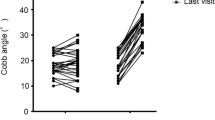Abstract
Purpose
Radiation-free systems based on dorsal surface topography can potentially represent an alternative to radiographic examination for early screening of scoliosis, based on the ability of recognizing the presence of deformity or classifying its severity. This study aims to assess the effectiveness of a deep learning model based on convolutional neural networks in directly predicting the Cobb angle from rasterstereographic images of the back surface in subjects with adolescent idiopathic scoliosis.
Methods
Two datasets, comprising a total of 900 individuals, were utilized for model training (720 samples) and testing (180). Rasterstereographic scans were performed using the Formetric4D device. The true Cobb angle was obtained from radiographic examination. The best model configuration was identified by comparing different network architectures and hyperparameters through cross-validation in the training set. The performance of the developed model in predicting the Cobb angle was assessed on the test set. The accuracy in classifying scoliosis severity (non-scoliotic, mild, and moderate category) based on Cobb angle was evaluated as well.
Results
The mean absolute error in predicting the Cobb angle was 6.1° ± 5.0°. Moderate correlation (r = 0.68) and a root-mean-square error of 8° between the predicted and true values was reported. The overall accuracy in classifying scoliosis severity was 59%.
Conclusion
Despite some improvement over previous approaches that relied on spine shape reconstruction, the performance of the present fully automatic application is below that of radiographic evaluation performed by human operators. The study confirms that rasterstereography cannot be considered a valid non-invasive alternative to radiographic examination for clinical purposes.



Similar content being viewed by others
References
Kane WJ (1977) Scoliosis prevalence: a call for a statement of terms. Clin Orthop Relat Res 126:43–46
Rose LD, Williams R, Ajayi B, Abdalla M, Bernard J, Bishop T, Papadakos N, Lui DF (2023) Reducing radiation exposure and cancer risk for children with scoliosis: EOS the new gold standard. Spine Deform. https://doi.org/10.1007/s43390-023-00653-6
Willner S (1979) Moiré topography for the diagnosis and documentation of scoliosis. Acta Orthop Scand. https://doi.org/10.3109/17453677908989770
Porto F, Gurgel JL, Russomano T, Farinatti PDTV (2010) Moiré topography: characteristics and clinical application. Gait Posture. https://doi.org/10.1016/j.gaitpost.2010.06.017
Treuillet S, Lucas Y, Crepin G, Peuchot B, Pichaud JC (2002) SYDESCO: a laser-video scanner for 3D scoliosis evaluations. Stud Health Technol Inf 3:70–73
Knott P, Mardjetko S, Nance D, Dunn M (2006) Electromagnetic topographical technique of curve evaluation for adolescent idiopathic scoliosis. Spine (Phila Pa 1976). https://doi.org/10.1097/01.brs.0000245924.82359.ab
Manca A, Monticone M, Cugusi L, Doria C, Tranquilli-Leali P, Deriu F (2018) Back surface measurements by rasterstereography for adolescent idiopathic scoliosis: from reproducibility to data reduction analyses. Eur Spine J. https://doi.org/10.1007/s00586-018-5645-6
Drerup B (2014) Rasterstereographic measurement of scoliotic deformity. Scoliosis. https://doi.org/10.1186/s13013-014-0022-7
Liu XC, Thometz JG, Lyon RM, Klein J (2001) Functional classification of patients with idiopathic scoliosis assessed by the quantec system: a discriminant functional analysis to determine patient curve magnitude. Spine (Phila Pa 1976). https://doi.org/10.1097/00007632-200106010-00020
Watanabe K, Aoki Y, Matsumoto M (2019) An application of artificial intelligence to diagnostic imaging of spine disease: estimating spinal alignment from moiré images. Neurospine. https://doi.org/10.14245/ns.1938426.213
Yang J, Zhang K, Fan H, Huang Z, Xiang Y, Yang J, He L, Zhang L, Yang Y, Li R, Zhu Y, Chen C, Liu F, Yang H, Deng Y, Tan W, Deng N, Yu X, Xuan X, Xie X, Liu X, Lin H (2019) Development and validation of deep learning algorithms for scoliosis screening using back images. Commun Biol. https://doi.org/10.1038/s42003-019-0635-8
Colombo T, Mangone M, Agostini F, Bernetti A, Paoloni M, Santilli V, Palagi L (2021) Supervised and unsupervised learning to classify scoliosis and healthy subjects based on non-invasive rasterstereography analysis. Plos one 16(12):e0261511
Weiss H, Seibel S (2013) Can surface topography replace radiography in the management of patients with scoliosis? Hard Tissue. https://doi.org/10.13172/2050-2303-2-2-437
Tabard-Fougère A, Bonnefoy-Mazure A, Hanquinet S, Lascombes P, Armand S, Dayer R (2017) Validity and reliability of spine rasterstereography in patients with adolescent idiopathic scoliosis. Spine. https://doi.org/10.1097/BRS.0000000000001679
Bassani T, Stucovitz E, Galbusera F, Brayda-Bruno M (2019) Is rasterstereography a valid noninvasive method for the screening of juvenile and adolescent idiopathic scoliosis? Eur Spine J (3). https://doi.org/10.1007/s00586-018-05876-0
Kim HE, Cosa-Linan A, Santhanam N, Jannesari M, Maros ME, Ganslandt T (2022) Transfer learning for medical image classification: a literature review. BMC Med Imaging. https://doi.org/10.1186/s12880-022-00793-7
Parsons VL (2017) Stratified sampling. Anonymous. Wiley StatsRef: Statistics Reference Online, New York, pp 1–11
Paszke A, Gross S, Massa F, Lerer A, Bradbury J, Chanan G, Killeen T, Lin Z, Gimelshein N, Antiga L (2019) Pytorch: an imperative style, high-performance deep learning library. Curran Associates Inc, New York
Carman DL, Browne RH, Birch JG (1990) Measurement of scoliosis and kyphosis radiographs. Intraobs Interobs Var 72(3):328–33
Gstoettner M, Sekyra K, Walochnik N, Winter P, Wachter R, Bach CM (2007) Inter- and intraobserver reliability assessment of the Cobb angle: manual versus digital measurement tools. Eur Spine J. https://doi.org/10.1007/s00586-007-0401-3
Acknowledgements
The study was fully supported by the Italian Ministry of Health (Ricerca Corrente).
Author information
Authors and Affiliations
Corresponding author
Ethics declarations
Conflict of interest
All the authors declare that they have no conflict of interest.
Additional information
Publisher's Note
Springer Nature remains neutral with regard to jurisdictional claims in published maps and institutional affiliations.
Rights and permissions
Springer Nature or its licensor (e.g. a society or other partner) holds exclusive rights to this article under a publishing agreement with the author(s) or other rightsholder(s); author self-archiving of the accepted manuscript version of this article is solely governed by the terms of such publishing agreement and applicable law.
About this article
Cite this article
Minotti, M., Negrini, S., Cina, A. et al. Deep learning prediction of curve severity from rasterstereographic back images in adolescent idiopathic scoliosis. Eur Spine J (2023). https://doi.org/10.1007/s00586-023-08052-1
Received:
Revised:
Accepted:
Published:
DOI: https://doi.org/10.1007/s00586-023-08052-1




